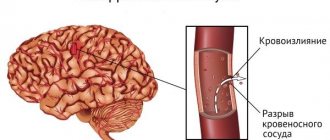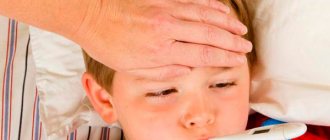The average normal temperature of the human body is 36.6ºC. Many diseases are accompanied by fever. Often, this symptom is one of the first to occur in infectious diseases. But some people suffering from VSD begin to notice that their temperature stays within 37-37.5ºC almost constantly or for a long time. This is frightening and makes you constantly worry.
Why does this vital indicator increase during neurosis and what are the reasons? What to do: sound the alarm or ignore it? How dangerous is elevated temperature? The answers to these questions will be discussed in the article.
Temperature deviations are within normal limits
In fact, a person’s temperature level constantly changes throughout the day. If you measure it every hour throughout the day, then anyone will see that in the morning it is slightly lower, then gradually increases, in the evening, at 5-6 o’clock, it can reach 37.0 ºC, and decrease again closer to sleep. And this is a completely normal process. Any healthy person never has a stable temperature of 36.6ºC throughout the day, and especially not a healthy person. In medicine, cases have been recorded in which people experienced chronic hyperthermia and hypothermia throughout their lives, as a genetic feature.
So what thermometer readings are the norm?
The natural, normal temperature of the human body is considered to be within 36-37 ºC.
The lowest critical level is 27°C. With this indicator, the person falls into a coma.
Dangerous temperature – 40°С. And the highest, critical mark of the thermometer, at which irreversible processes begin in the brain and body, is 42°C. At a temperature of 45°C, a person faces death.
Low-grade fever with VSD
Low-grade fever is an indicator in the range of 37.1-38ºС. Doctors say that low-grade fever observed for 1-2 days, not accompanied by other symptoms, has no pathological significance for the human body. This can happen from experiencing severe stress, when encountering certain viruses and bacteria that suppress our immunity, preventing us from getting sick. But if a low-grade fever persists in the body for more than 3 days, this is a sign of a clear disorder.
With VSD, low-grade fever can last for a long time - a week, a month, or even several months. What happens in the body of a neurotic person, why does the temperature stay at 37-37.5ºС?
Causes of low-grade fever in dystonia
The autonomic nervous system controls all unconscious functions in the human body, including thermoregulation. With VSD (neurosis), a serious failure of this system occurs, and everything literally begins to work out of kilter. This is where these strange and numerous physical symptoms arise.
Thermoregulation control is simply disrupted, which is why the VSD sufferer feels hot, cold, sweating, or chills. It happens that during panic attacks the face burns, while the hands and feet are icy.
Acute neurosis is accompanied by constant tension and frequent surges of adrenaline. As soon as the next release of adrenaline occurs, the body mobilizes, the blood vessels narrow, and blood drains from the digestive organs and bladder. And since the blood supply to some organs slows down, the temperature drops.
The hypothalamus generates a signal about emergency heating of the body - the temperature begins to rise. There are cases when, during panic attacks, people's temperature rose to 38ºC.
And if the body is under chronic stress, then there is absolutely nothing surprising in the fact that a low-grade fever persists almost constantly, or is observed during anxiety attacks and for some time after them.
Typically, dystonics rarely experience temperature fluctuations. If, for example, with a cold, even a slight increase in heat in the body is felt quite clearly, then with VSD there is no fever or aches, since they appear due to infection. People with neuroses most often find out about their low-grade fever by constantly measuring their temperature.
Thus, low-grade fever develops into another hypochondriacal disorder - constant manipulation of the thermometer, anxious thoughts about possible diseases that cause chronically elevated temperature, new attacks of panic attacks... and so on ad infinitum.
Symptoms and treatment of gastric neurosis
The symptoms of dyspepsia are very diverse and are rarely expressed only in the destructive functioning of the gastrointestinal tract. Typically, a person suffering from a psychosomatic illness experiences general malaise in addition to pronounced gastric upset.
This is why some people start taking antispasmodics, carminatives, enzyme preparations, and do not feel obvious improvements. The lack of results and relief leads to thoughts that the disease is more severe than it seemed, which only worsens the condition, developing hypochondria. A vicious circle occurs.
READ MORE: How to treat boils during pregnancy
Let's look at the main symptoms of the disease.
- Decreased appetite or its sharp increase.
- Nausea, vomiting.
- Diarrhea, constipation, or alternation of both.
- Non-localized pain in the stomach, abdomen.
- Bloating, flatulence, constant rumbling, distension, colic.
- Heaviness in the stomach.
- Constriction in the esophagus.
- Aerophagia (frequent belching caused by excessive swallowing of air).
- Heartburn.
- Changes in food preferences (favorite foods may begin to cause disgust or, conversely, an addiction to something that does not cause appetite begins).
Symptoms of esophageal neurosis:
- Lump in the throat.
- Feeling of difficulty passing food.
- Compression in the neck and chest.
Associated symptoms:
- Weakness, malaise, lethargy.
- Low temperature (within 37.5).
- Headache.
- Increased sweating.
- Constantly cold palms and feet.
- Muscle weakness, trembling.
- Frequent urination.
- Drowsiness, fatigue during the day and poor sleep at night.
- Low performance.
There is another type of dyspepsia of a psychogenic nature, affecting the upper organs of the digestive system. Neurosis of the upper esophagus is a sphincter in the throat that spasms. A person begins to feel a lump in the throat, has difficulty swallowing food, experiences severe discomfort, sometimes chest pain, headaches, tension in the jaw, and difficulty breathing.
Sometimes the spasm is so strong that it is impossible to swallow even liquid food. Most often, a lump appears suddenly, from a strong psycho-emotional shock.
Further, treatment is aimed at eliminating the spasm (antispasm drugs are used), relaxing the nervous system and eradicating the root cause of the symptom.
If you discover esophageal neurosis, it is better not to delay the problem and immediately seek help from specialists, otherwise the situation may worsen to the point of inability to eat.
What to do if the temperature stays between 37-37.5 degrees?
To begin with, of course, it is recommended to undergo diagnostics and rule out organic diseases. If no serious diseases are found in the body that provoke low-grade fever, then you should relax.
Low-grade fever is not dangerous and there is no need to bring down such a temperature. The following signs indicate that the cause of hyperthermia is a failure of thermoregulation:
- The thermometer readings are unstable during the day - the temperature changes depending on the time of day and condition.
- The levels increase during physical activity and often during panic attacks.
- During sleep, the thermometer mark drops below 36.6°C. This can be recorded by setting the alarm clock for 2-3 am and measuring the temperature.
- In a calm, lying, relaxed position, the temperature is close to the average norm.
- There are no signs of acute infectious diseases.
Important! A temperature that rises sharply above 38°C, even if not accompanied by other symptoms, is no longer considered low-grade and requires urgent consultation with a doctor.
How to normalize temperature
There is no need to go out of your way to achieve the ideal thermometer reading. In general, it is better not to attach importance to this symptom of VSD and stop bothering with a thermometer.
Treatment of neurosis with folk remedies, reviews of those who were cured
Has anyone treated neurasthenia? Please tell me what helped someone, do you want fewer pills, more herbal preparations? But valerian alone won’t help matters (
Find out the opinion of an expert on your topic
Psychologist. Specialist from the site b17.ru
Psychologist. Specialist from the site b17.ru
Psychologist, Gestalt therapist. Specialist from the site b17.ru
Psychologist, Clinical psychologist, oncologist. Specialist from the site b17.ru
Psychologist. Specialist from the site b17.ru
Psychologist, Online consultant. Specialist from the site b17.ru
Psychologist, I make dreams come true at a reasonable price. Specialist from the site b17.ru
Psychologist, Emotional-imaginative therapist. Specialist from the site b17.ru
Psychologist, Online consultant. Specialist from the site b17.ru
Psychologist, Psychoanalyst. Specialist from the site b17.ru
AND WHAT IS IT EXPRESSED IN? AND WHAT DID YOU THINK THAT YOU HAVE NEURALITY?
almost all the symptoms, 2 years ago I had neurosis, I wouldn’t want to go back on potent drugs
find out the psychological cause and eliminate it. Fill yourself with positive emotions.
Calm and only calm!
Calm and only calm!
Maybe I just have severe chronic pain. fatigue. Did St. John's wort help anyone?
Author, why do you have neurasthenia and who diagnosed you? How do you express this?
Chronic fatigue and neurasthenia are the same thing. St. John's wort has a mild antidepressant effect, but it is unlikely to help here. If you take a herbal one, then a stimulating one - ginseng, eleutherococcus, lemongrass, but they are not always suitable, since your nervous system is probably at its limit. Still, you need to see a doctor.
call on skype doktorduha. We will help you understand the cause of chronic fatigue and neurasthenia. Or go to the website www.doktorduha.my1.ru
I suffered from neurasthenia for many years. Psychoanalysis helped me. I'm going through my second year. I feel my strength returning, the desire to live and do something. Before psychoanalysis, I took medication and was treated by a psychotherapist, the result was minimal. You need to understand yourself, look for and work through the traumatic moments of the past that led to the disease. It's not easy and it's unpleasant. But there are results.
Has anyone treated neurasthenia? Please tell me what helped someone, do you want fewer pills, more herbal preparations? But valerian alone won’t help matters (
I also have the same diagnosis, neurasthenia. I don’t know how to get rid of it myself. Help.
There are mild soothing vitamin remedies. Write me. Let's talk E-mail ICQ 424602330 SKYPE millionershav tel. (mobile) +38067233442
I suffered from neurasthenia for many years. Psychoanalysis helped me. I'm going through my second year. I feel my strength returning, the desire to live and do something. Before psychoanalysis, I took medication and was treated by a psychotherapist, the result was minimal. You need to understand yourself, look for and work through the traumatic moments of the past that led to the disease. It's not easy and it's unpleasant. But there are results.
Irina, be so kind. write which analyst you go to and, if possible, give his coordinates.
try drinking "dried seafood. sea cucumber." great thing, I sit on it myself. cool!
If you are not surrounded by friends and you are constantly alone and have no one to talk to or have a nice walk, then no amount of psycho-training will help. I have neurasthenia, good weather, I feel good, I feel bad right away! Or for example, you communicate with some friends, the next day the same thing, but you feel that they are not reacting to you, you are going into the shadows! And then neurosis begins again. The solution to neurosis is simple: to always be on top of everything; if something moves in the wrong direction, the neurosis will return!
I have been suffering from neurasthenia for 3 years. I can’t get out of bed, headaches, ringing in the ears, spots in front of my eyes, gallstones, urination problems, heaviness and pain in the heart, a terrible condition, I was treated with strong drugs, it’s only worse, can anyone tell me what to do? ?conducted psychoanalysis, but there’s no point, just suffering and depression..
“Potion” (that’s what we call it at work) for neuroses. I work in a hospital (financial worker), our neurologist wrote us a prescription. So here it is at home and at work (public jar) Write it down, you won’t regret it! Recipe for sedative Validol - 6 tablets. crush into powder. Corvalol - 1 belly. Motherwort - 100 g Hawthorn - 50 g Valerian - 50 g Colendula - 1 puz. Mix everything and leave for a day. Take - 1 tsp. half a glass of water, 2-3 hours before bedtime. About a week or two. And then just store it in the refrigerator. You can then use it once at a time when you just need to calm down - the effect is instant! Can be stored in the refrigerator for years.
I had chronic neurasthenia, it reached a severe stage - the third stage, when you are practically a vegetable, it was even difficult to move. I visited several psychiatrists - all to no avail, spent 1.5 months in the crisis ward on Babushkinskaya, a bunch of pills - zero effect. I came home in the same condition, well, at least I passed the examination. As a result, she diagnosed herself and was cured herself. First, I downloaded the auto-training and started listening to it three times a day (I don’t remember the name, it’s read by a woman, the tracks are about 12 minutes long). At first I couldn’t relax, but then I started to really enjoy myself. Then I accidentally read Kurpatov’s book (although I was very skeptical about this author) “A Remedy for Fatigue” and it at least explained to me what was happening to me. True, the exercises he gave there didn’t really suit me. From experience I can confidently say that pills and herbs in treatment as such do not help to recover. But they can help you do exercises that actually lead to recovery. Although you can do without pills/herbs altogether. And even valerian and products with ginkgo extract will be enough. Naturally, it is advisable to establish a routine for sleep, nutrition, walking, etc. It is clear. But the main thing is exercise, attitude and psychotherapy.
The above-mentioned book talks about attitude. Psychotherapy - to work through problems, i.e. assessment of the current situation and your life in general. It is possible without the help of a doctor. Auto-training for relaxation and stabilization of the autonomic system. And also, during the day, try not to think, not to conduct a mental dialogue with yourself. This “exercise” helped me. When, for example, you walk down the street or are busy with household chores, we try to turn into hearing. Just listen to sounds without judging them, without thinking, etc. At first it doesn’t work out well, but then it will be great for helping the brain rest, especially on the street, when everything and everyone is tense there. You start listening and you come into a state of relaxation and composure at the same time. Or you can passively concentrate on relaxing the muscles of your right (left) arm and face - this is good when you are sitting in transport. The main thing is to do and do and improvement will gradually come. This is true. I wish everyone patience in this difficult struggle! And who thinks that you can recover from this crap only with pills and just talking about your problems with your doctor - try it, although it’s better not to waste your time and health.
Nothing helps me, I have a bunch of concomitant diseases, I’ve driven myself crazy. How did you get yourself into this state?
Hello! My name is Rose, I have the same problem. About 3 months ago I was diagnosed with the following symptoms of VSD (dizziness, fear of death, difficulty breathing in crowded places, problems sleeping, etc.) I was afraid of the most basic ones. I completed a course of treatment (Milgama, Gandaxin, Nootropil, Mildronate, Glycine, Mg B6, Actovigin), which seemed to indicate everything. But the treatment did not give the desired result, of course it became easier, but the cloudiness in my head remained, and the ponic otaki periodically cut off. Tell me please, maybe it’s not VSD, but something with the psyche?
Hello, help, 10 years of my life were spent talking to the doctor and taking pills, in the end everything went down the drain, the symptoms are also lack of air, in public places there are also unfounded fears and a terrible convulsive state of the limbs and facial muscles. I drank neuramine, sedavit, even took antihistamine neuroleptics, the effect completely killed me, neuralgia of the facial muscles and hormonal imbalance appeared.
try the herbal mixture phytosedan-3. after a year and a half of antidepressants and unsuccessful treatment (there was depression due to a somatic illness). I couldn’t sleep and cried for two days - the collection helped me fall asleep and be calmer. If you can get by with strong drugs, don’t put them in your mouth. If you still have problems, I can recommend Sonapax. We don’t need to cheer you up, but on the contrary, we need to calm you down. tonics are not really your thing. Before I had depression, I also had neurasthenia (I won’t say what it was) - without treatment, it brought me to complete disaster, and then depression came in its place.. so, don’t start the process.
Anya, and more. Some infectious diseases cause CFS, which only gets worse. If you have CFS, a lack of strength, there is no point in cheering up, but you need to be checked for such diseases as the Epstein-Barr virus (in the end, it turned out to be the cause of my prolonged depression and it still torments me) and cytomegalovirus. These two bastards give precisely CFS, pain in the organs, etc. etc. Get checked, I’m serious, just get your titres tested for antibodies to both viruses and we’ll see.
almost all the symptoms, 2 years ago I had neurosis, I wouldn’t want to go back on potent drugs
I suffered from neurasthenia for many years. Psychoanalysis helped me. I'm going through my second year. I feel my strength returning, the desire to live and do something. Before psychoanalysis, I took medication and was treated by a psychotherapist, the result was minimal. You need to understand yourself, look for and work through the traumatic moments of the past that led to the disease. It's not easy and it's unpleasant. But there are results.
Five years have passed since I was diagnosed with neurasthenia, sad, but not fatal, as it turned out. At the beginning, everything was very bad and it seemed that this terrible condition would never end, but time and the desire to regain health bore fruit - now I feel almost good)) I want to share my experience. Firstly, you must undergo a course of treatment (from a psychiatrist), secondly, change your lifestyle, which brought you to this state (I threw away everything, even my husband) thirdly, be patient (because it takes a long time) and believe, very have strong faith in your recovery. Now I’m happy and enjoying everything I didn’t notice before. I wish everyone success in this difficult task.
Has anyone treated neurasthenia? Please tell me what helped someone, do you want fewer pills, more herbal preparations? But valerian alone won’t help matters (
Well, we must not forget that everyone has a different nervous system. In addition to different temperaments, there is also introversion and extroversion. It will be extremely difficult to cure a neurotic introvert, and they are precisely the ones most prone to such neuroses. I don’t want to upset you, but I am convinced that psychotherapy in our country is still at the level of “shamanism”. The surgeon, at least, knows from anatomical atlases what a healthy organ should look like. But how to assess mental health? Where is the criterion? Happiness? “So I know several people with personality disorders who are happier than many ordinary people.” They live in their own semi-adequate world, and generally don’t worry about anything. It is very simple to treat to a state of happiness - they will prescribe you, say, Prozac, and you will instantly become happy, and everything in life will be easy and work out well. But you won’t be able to stop taking it. If you go to a doctor, ask him at least to begin with, what does he mean by a healthy personality? What are his criteria for a healthy nervous system? Because I personally came to the conclusion that a negative attitude towards such a life, as in our tenth world countries during the heyday of stagnation, is much more adequate and normal than the joyful exclamations of “optimists”, which are more reminiscent of the slogans of zombified fanatics of the system.
I have been suffering from neurasthenia for 3 years. I can’t get out of bed, headaches, ringing in the ears, spots in front of my eyes, gallstones, urination problems, heaviness and pain in the heart, a terrible condition, I was treated with strong drugs, it’s only worse, can anyone tell me what to do? ?conducted psychoanalysis, but there’s no point, just suffering and depression..
Anya, and more. Some infectious diseases cause CFS, which only gets worse. If you have CFS, a lack of strength, there is no point in cheering up, but you need to be checked for such diseases as the Epstein-Barr virus (in the end, it turned out to be the cause of my prolonged depression and it still torments me) and cytomegalovirus. These two bastards give precisely CFS, pain in the organs, etc. etc. Get checked, I’m serious, just get your titres tested for antibodies to both viruses and we’ll see.
source
Topic: psychiatry. We discuss current issues in psychiatry.
Here you can get the doctor's answer
Discussion of psychiatry news from the RSS feed of the site https://neuroleptic.ru/psynews/feed.rss
Sexual problems. Everything that has to do with sexual life - libido disorders, erectile dysfunction, etc.
Everything that does not fit into other sections, but is related to psychiatry
Search for a psychiatrist, psychotherapist, narcologist, sexologist. Reviews of doctors and clinics
Problems of drug addiction are discussed. Features of the course and treatment of chemical addictions
Collapse Psychopharmacotherapy: discussion of drugs, reviews Psychopharmacotherapy: discussion of drugs, reviews
|
|
|
|
|
|
|
|
|
|
|
|
|
|
|
|
Discussion of antipsychotic drugs (neuroleptics): indications, contraindications, use, side effects. Reviews about antipsychotics
We discuss antidepressants (thymoleptics): indications, contraindications, use, side effects. Reviews about antidepressants. Selection and search for antidepressants.
We discuss anxiolytics (tranquilizers): indications, contraindications, use, side effects. Reviews of tranquilizers.
We discuss mood stabilizers (mood stabilizers): indications, contraindications, use, side effects
Drugs that improve cognitive function - anti-dementia drugs. Reviews of drugs for the treatment of dementia. Choice of drug for dementia
We discuss nootropics, antihypoxants, metabolic regulators, and “vascular” drugs. Drugs without evidence base
| Forum | Statistics | Last message |
|
| |
|
| |
|
| |
|
| |
|
| |
|
| |
|
|
Collapse Mental disorders - advice and consultations Mental disorders - advice and consultations
Schizophrenia, schizoaffective disorder, schizotypal disorder
Depression, mania, dysthymia, cyclothymia. Bipolar affective disorder (manic-depressive psychosis). Resistant depression.
Panic attacks, generalized anxiety disorder, social phobia, fears, phobias, anxiety
OCD, Tourette's syndrome, anorexia, bulimia, urge disorder, paraphilias, non-chemical addictions, trichotillomania, etc.
Consequences of TBI, “vascular” diseases, epilepsy
Neuroleptics, antidepressants, tranquilizers, mood stabilizers.
Questions on mental disorders in childhood. Hyperactivity, developmental disorders, autism.
| Forum | Statistics | Last message |
|
| |
|
| |
|
| |
|
| |
|
| |
|
| |
|
| |
|
| |
|
|
Problems of psychotherapy and clinical psychology are discussed
You can get advice from a psychotherapist
Everything that is not related to clinical psychology
| Forum | Statistics | Last message |
|
| |
|
| |
|
|
Everything related to the rest of medicine is here. Those. not psychiatry.
Questions about the functioning of the site and forum.
Online testing: questions, results, discussion
OFTOP. Everything that does not fit into other topics is here.
source
Neuroses are a common mental disorder that is caused by chronic stress and psychologically difficult situations.
Neuroses are characterized by a strong feeling of unhappiness or internal torment, not caused by any specific reasons or events in life. Due to illness, a person is often unable to work normally, and his personal life also suffers. But the disease does not make you unable to work. The patient does not lose touch with reality and is quite critical of his condition. This is the main difference between neurotic disorders and psychoses.
Most psychotherapists and psychiatrists are confident that neurotic disorders are the result of internal subconscious conflicts between different desires, impulses and motivations.
“Unacceptable” taboo impulses (aggressive aspirations, sexual cravings, painful memories) repressed into the subconscious try to break back into consciousness. But the mind defends itself by building various protective barriers. However, sometimes suppressed impulses manage to temporarily overcome the defense. Then the subconscious seems to collide head-on with the consciousness, which gives rise to a persistent neurotic reaction.
People suffering from neurotic disorders easily succumb to stress and react extremely painfully to them. Often, even generally ordinary situations cause a strong negative reaction in them, small disappointments take away strength for a long time, and minor failures lead to despair.
Neurosis gives rise to short temper and mood swings. Treatment for this condition should begin as early as possible .
Most neuroses are formed in childhood. Most often they appear when a child experiences a strong shock (divorce of parents, tragic events, temporary separation from relatives).
The main subtypes of neuroses traditionally include:
- Obsessive states.
- Hysteria.
- Anxiety disorders (including phobias).
- Neurasthenia.
- Obsessive-compulsive disorder (obsessive-compulsive disorder) is characterized by the constant intrusion into the consciousness of unwanted thoughts, ideas, feelings, or the performance of periodically repeated ritual actions that temporarily relieve anxiety.
Obsessive ideas can be persistent inappropriate thoughts or a persistent desire to cause harm. With compulsive behavior, a person may, for example, periodically wash their hands to avoid infection or check that the entrance doors are closed to feel safe.
- Neurotic hysteria is characterized by various psychogenic manifestations. A person (most often a woman) can go blind or become paralyzed, although there are no physiological prerequisites for this, everything is fine with the optic nerve, and the bones are intact. Hysteria is characterized by emotional expansiveness, a tendency towards drama and theatricality. During attacks of the disease, a person may begin to moan, sob loudly, or try to harm himself.
- The main distinguishing feature of anxiety disorders and phobias is unmotivated concerns and fears. The disease takes the form of short, sharp panic attacks or a chronic feeling of unaccountable anxiety.
Panic attacks cause a number of painful reactions: a person has a headache, heart problems begin, his sleep and digestion are disturbed, and his appetite disappears.
If you have phobias, a person is attacked by wild fear when certain conditions arise: for example, when he finds himself in a confined space or rises to a great height, when he sees mice or gets his hands dirty.
- Neurasthenia. The main signs of the disease include severe irritability and very rapid mental and physical exhaustion. Neurosthenics are very impatient and have frequent mood swings. Such patients have a hard time at heart, a pessimistic attitude towards life prevails. They find it difficult to think and work. The appetite of neurasthenics is reduced and sleep is poor.
There are many ways to treat the disease. For example, psychoanalysts help to understand what repressed desires or traumatic memories are its cause. This knowledge can relieve frustration.
Adherents of behavioral therapy treat neuroses as a kind of acquired conditioned reflexes that can be “desensitized,” that is, dulling sensitivity to them. For example, if a person is afraid of heights, then he will gradually weaken this phobia if he rises higher and higher, step by step.
Another effective psychological approach to treating the disorder is called behavior modeling. The patient simply learns to behave differently from the example of healthy people.
Neurosis can also be overcome using cognitive techniques: the patient discusses with the doctor what thoughts and feelings become a catalyst for neurotic symptoms; and so gradually talking through the problem, he begins to look at it calmer, and painful reactions are replaced by normal ones.
In case of acute manifestations of obsessive states, hospitalization for inpatient psychoneurological treatment cannot be ruled out. But more often they do without it. The patient can also visit a psychotherapist and participate in group classes and hypnosis sessions.
When a person develops obsessive-compulsive disorder, treatment at home using one’s own volitional efforts usually does not produce any results. Therefore, the main direction of treatment is psychotherapeutic influence. Drug treatment plays only a supporting role.
In pregnant women, the symptoms of a neurotic state have their own characteristics. For example, in such women:
- the emotional background is very low, and the general depression is too high. Consistently bad mood and dark thoughts, apathy and severe irritability predominate;
- specific phobias develop: a woman is afraid that a miscarriage will occur or a child will be born with illnesses; it may seem to her that her husband is no longer attracted to her;
- various psychogenic manifestations: severe dizziness, arrhythmia, sweating, etc.
Treatment of neurosis during pregnancy does not involve taking any psychotropic drugs. You just need to change your lifestyle and use psychotherapeutic techniques. It is extremely important to begin treatment of pregnancy neurosis as soon as its first signs appear.
But sometimes psychotherapy does not bring the desired result. In this case, treating neurosis with folk remedies and taking herbal-based sedatives can be effective.
Occurs due to emotional overload and severe stressful situations. Accompanied by dysfunctions in the autonomic nervous system. Women develop anxiety neurosis much more often than men (approximately 2 times).
Symptoms of the disease include:
- mental disorders - severe anxiety, reaching the point of horror, short temper, despondency, sleep problems;
- disorders of the somatic and autonomic system - migraines, arrhythmias, difficulty breathing, stomach problems.
In advanced cases, the disease causes complications in the form of clinical depression or obsessive-compulsive disorder.
Herbal medicine will come in handy here. To treat the disorder, it is advisable to use medications with motherwort, St. John's wort, valerian root and fireweed.
You can prepare herbal infusions that have a mild hypnotic and calming effect.
If the matter has reached the acute stage, then the use of tranquilizers and antidepressants is permissible for the treatment of anxiety neurosis. If herbal infusions do not help you sleep, you can additionally take a mild sleeping pill.
After fears and panic attacks subside, it is worth attending psychotherapeutic sessions. The duration of treatment for neuroses is largely determined by the timeliness of the start of therapy. Improvement in the condition and complete remission can occur within six months.
Many people are afraid of psychotropic drugs. But modern antidepressants and tranquilizers are very effective and do not pose a great danger to health. So the use of psychopharmacotherapy along with psychotherapy methods is completely justified. Psychotropic drugs show excellent results in the treatment of depressive neuroses, obsessive disorders, anxiety disorders and phobias. Even their short-term use brings significant relief to patients. Psychotherapy sessions become much more effective thanks to tranquilizers and antidepressants. The unbearable feeling of fear and anxiety goes away without a trace.
For chronic neuroses, long-term pharmacotherapy is advisable. It must be combined with supportive psychotherapy.
Unfortunately, no one knows exactly how to cure neurosis at home without drugs and doctors. So you should not be afraid to take psychotropic drugs.
ASD helps increase the body's defenses. Fraction ASD-2 is taken orally. It activates:
- nervous system;
- work of the gastrointestinal tract;
- digestive and tissue enzymes;
- processes of nutrient absorption.
Treatment of neuroses with the ASD-2 fraction is also possible. To obtain a therapeutic effect, it is enough to take a maximum of 20 drops per day. The dose increases gradually. You need to start with five drops twice a day. Only after a week the intake is increased to ten drops (twice a day). The duration of therapy is a month.
If signs of nervous system overstrain appear, the ASD-2 fraction should be discontinued.
Unfortunately, this remedy is not always effective against neuroses. Shales also bring rather modest results in treating the disease.
It is quite possible to treat neurosis with folk remedies. A number of plants, the healing power of which was discovered many centuries ago by our wise ancestors, are considered to really help against illness. Numerous modern methods of treating neuroses at home using decoctions and tinctures of various medicinal herbs came from them.
First of all, you should pay attention to plants that have a sedative effect. Tinctures and decoctions prepared from them should be taken before bed.
In the morning, preference should be given to plants that have stimulating and tonic properties. Among them it is necessary to highlight Leuzea, Schisandra, and Rhodiola.
Treatment of neurosis with herbs includes hundreds of different recipes: Here are some of the most effective ones:
- Prepare two pieces each of mint leaves and three-leaf watch, one each of hop cones and valerian root. Mix everything and separate 50 grams. Pour into a small container and pour in 0.25 liters of boiling water. The infusion can be taken within twenty minutes. The drink works great, “quenches” obsessive states, and eliminates insomnia.
- Mix three particles of chamomile flower, two of valerian (root) and five of cumin. Brew similarly to the previous recipe. The infusion will help you fall asleep and reduce obsessive fear.
- Mix equal amounts of cumin and fennel, motherwort and valerian (root). Prepare as described in the first recipe.
- Send two leaves of golden mustache to a cold place and leave for ten days. Then chop and pour half a liter of boiling water. Leave for about an hour, strain through cheesecloth into another bowl.
Pour 50 grams of heather with a glass of boiling water and simmer for 10 minutes over low heat. Leave for two hours and strain. Pour the heather infusion into a cup, add a spoonful of golden mustache and drink like tea.
- Voronets roots help reduce hysteria. Brew 70 grams in 0.3 liters of boiling water for a quarter of an hour. The infusion is consumed three times a day, one tablespoon.
Treatment of neurosis with folk remedies that actually help will eliminate the danger of developing dependence on medications and protect against their unpleasant side effects.
Folk remedies for neurosis include taking baths with warm water. They need to add soothing herbal decoctions or pharmaceutical pine needle extract. It is also possible to add aromatic oils (lavender, mint), which also have a positive effect.
Vitamins . It is best to get them from food, selecting only healthy ones.
When neurotic symptoms just begin to make themselves felt, B vitamins are effective. Ascorbic acid will protect the body and restore strength. Therefore, the diet should contain foods rich in it. Including:
- eggs and milk;
- cottage cheese and oatmeal;
- beef liver and pork;
- legumes;
- fish and vegetable oil;
- citrus and red fruits.
Physical education . It will help relieve muscle tension caused by neurosis.
Breathing practices . They have a calming effect on the psyche.
There are plenty of ways to treat nervous disorders. Treatment with folk remedies can also help, but it’s better to consult a psychotherapist or psychiatrist.
source
0
Did you like the article? Share with friends:
You may also be interested
Recipes from the people
Stye in a child: how to treat folk remedies
Barley is an acute inflammatory disease of the eye that can appear in a person of any age.
Recipes from the people
How to quickly cure barley in a child using folk remedies
Many people have encountered such a “surprise” as stye on the eye. Swelling appears on the eyelid and
Recipes from the people
Barley in a 2 year old child - folk remedies
Barley is an acute inflammatory disease of the eye that can appear in a person of any age.
Recipes from the people
Stye under the eye treatment with folk remedies
What to do if stye grows on the eyelid? How to treat stye on the eye at home
Recipes from the people
Barley initial stage treatment with folk remedies
What to do if a stye develops on the eye? It is better to treat stye on the eye with folk remedies
Recipes from the people
Stye has started, what to do, folk remedies
What to do if a stye develops on the eye? It is better to treat stye on the eye with folk remedies
Add a comment Cancel reply
Site search. Enter your query:
about the author
Hello, friends! My name is Nikolai Vakulenko. On the pages of my online magazine, I collect a variety of interesting, educational and curious information from a variety of sources, process, check and post. Information both from our sources and from foreign ones. If you see errors and inaccuracies, write about them in the comments or email me. Also, I will always answer any questions. Be healthy! Do not be ill! Take care of yourself!
Healthy
Why do you need a germicidal lamp?
What is hand hygroma?
Anemia is a deficiency of vitamin B12. Main causes and diagnosis
Iron-deficiency anemia. What is iron deficiency in the body?
What is achondroplasia? What kind of disease is this?
- Privacy Policy
- Copyright holders
© 2020 MDROIT.com Attention! The information published on the site is for informational purposes only and does not constitute a recommendation for use. Be sure to consult with your doctor!
Adblock detector
| Forum | Statistics | Last message |
|
| |
|
| |
|
|
Why is there an elevated temperature with VSD?
Temperature jumps during VSD occur due to disturbances in the functioning of the peripheral nervous system, which cause vascular dysfunction. This negatively affects the body's ability to thermoregulate. Generally speaking, body temperature is maintained by constricting or dilating blood vessels. With VSD, brain signals may not reach the peripheral parts.
Causes of failures in the body’s thermoregulation due to neurocirculatory dysfunction, or vegetative-vascular dystonia:
- Dysfunction of the thermoregulation center located in the hypothalamus;
- adrenaline release during anxiety, panic attacks, etc. phenomena during VSD;
- a person’s fear at the first manifestations of VSD, anxiety about a possible jump in temperature: oddly enough, after this it can actually rise.
Temperature deviations are within normal limits
Everyone knows that the normal temperature of the human body is 36.6 degrees Celsius. But some people constantly live (and feel great) with slight deviations from this indicator. Each organism has a number of its own individual characteristics. For some people, 36.3 is the normal body temperature. For others, the usual figure is 36.8, -37.0, or even 37.3. Conclusions about the norm are made on the basis of observations of well-being, after examinations confirming the absence of diseases.
Important! It is worth considering that in children under 1 year of age, the normal temperature may fluctuate due to the fact that the thermoregulation system is still being formed.
For most people, the above-mentioned deviations in body temperature cause some kind of discomfort. So, often a person who has a headache, having tried to relieve the pain with a pill to no avail, thinks of taking his temperature just in case. To his surprise, he finds himself at 37.0.
A typical case of increased temperature during VSD is supplemented by heart rhythm disturbances, changes in blood pressure, headaches, and heart pain. You may experience chills, tremors, coldness in the extremities, and increased sweating.
The temperature rises to 37.0 - 37.5, sometimes even up to 38.0 degrees. As a rule, having reached 38.0, it soon begins to slowly subside. If the thermometer creeps higher, reaching 39.0 degrees, you need to be wary. Such a high temperature is not typical for VSD - it may be a sign of another, more dangerous disease.
Causes and symptoms of thermoneurosis
The hypothalamus controls body temperature and is the body's thermoregulation center. It is responsible for maintaining optimal body temperature in conditions of changes in external temperatures and the development of infectious diseases. In the presence of thermoneurosis, due to spasm of blood vessels, this process is disrupted, body temperature rises to subfebrile and does not decrease for a long time. In this case, the person feels sick.
The causes of the pathology are not fully understood; it occurs as a reaction of the body to negative factors, including:
- prolonged state of stress;
- excessive psychological and physical stress;
- lack of sleep;
- depression;
- previous head injuries;
- hormonal imbalance;
- some endocrine diseases;
- bad habits;
- increased anxiety and tendency to worry.
The occurrence of symptoms of the pathological condition is due to vasospasm. They often arise before a crucial event, after severe stress and anxiety, or during conflicts. Signs of thermoneurosis include:
- increase in body temperature to +37… +38°C;
- weakness;
- feeling of aching;
- pain in the temporal part of the head;
- insomnia;
- fainting state;
- heart rhythm disturbance;
- pressure changes.
In children, thermoneurosis is often diagnosed in preschool and primary school age. There is also an increase in temperature in adolescents during puberty. If a child develops the corresponding symptoms, it is necessary to examine him by a neurologist, if other diseases are excluded.
In infants, the pathology can be caused by stress due to the cessation of breastfeeding; in preschoolers, it is often triggered by worries about entering kindergarten. At the same time, as soon as the stressful situation passes, the condition sharply normalizes.
The following factors can lead to the development of a pathological condition in children:
- severe pregnancy;
- hypoxia;
- anemia during pregnancy;
- trauma during childbirth;
- disruption of the nervous system;
- head injuries.
Low-grade fever with VSD
In descriptions of the symptoms of some diseases and syndromes, including VSD, the term “low-grade fever” is used. The condition of the body in which such a temperature occurs and persists is called subfebrile condition. The causes of this condition may vary.
What does this mean?
Low-grade fever is a body temperature raised to a level from 37.0 to 37.9. Higher rates (38.0 and above) usually occur against the background of pronounced manifestations of a disease. It is by the combination of these signs that the doctor can accurately make a diagnosis.
With low-grade fever, making a diagnosis is difficult because you need to analyze a whole list of too specific symptoms. In different combinations they can lead to completely different diseases.
Presence of infectious and inflammatory diseases
Appearance is high
high temperature is most often associated with the appearance of chronic infectious and inflammatory diseases. Often the cause of a febrile state, in which headache and aches are felt for several weeks, is tuberculosis of the genitourinary system, spleen, lungs, spine, and lymph nodes.
This disease is dangerous because it is asymptomatic. Even when conducting an X-ray examination and taking tuberculin samples at an early stage of the disease, the indicators are mild and in some cases give a negative result. If the fever does not subside for more than a month, this may be the main signal of the development of this dangerous disease.
If the patient is only febrile, this may indicate the presence of:
- Pyelonephritis;
- viral hepatitis B and C;
- cholangitis in the form of inflammation of the bile ducts;
- HIV infection, mycobacteriosis, fungal infections in the form of coccidioidomycosis and histoplasmosis.
When the elevated temperature remains at a level of 37 to 39 degrees for a month or more, the reason may lie in the formation of pus in the abdominal cavity and pelvic cavity. However, there may be no visible symptoms. This condition can usually be seen in people in their years, when immunity decreases and the body’s defense mechanisms are weakened.
If a fever is attributed to a cold, the patient is usually in no hurry to see a doctor and tries to be treated at home, thereby losing the moment when it is possible to stop the development of a serious illness. By the way, it is worth noting that sometimes a cold without fever can develop.
An abscess occurs on the walls of the intestines, in the kidneys, prostate gland, and liver. Suppuration can form in the presence of abdominal injuries, chronic intestinal infections, diabetes mellitus, and cirrhosis of the liver.
A temperature of 37-38 degrees occurs with endocarditis - inflammation of the inner lining of the heart. However, the source of such a disease is very difficult to identify. It is dangerous because the inflammatory process affects the heart valves.
Pain and aches can be a sign of osteomyelitis - a purulent-inflammatory process in the bones and bone marrow. This disease occurs in people who have suffered severe trauma or have professional activities associated with high physical activity.
An increase in temperature during osteomyelitis is the first symptom of a disorder in the body; therefore, it is necessary to do a full examination and tests.
What to do if the temperature stays between 37-37.5 degrees?
If an adult’s body temperature rises daily and remains above 37 for a long time, it is necessary to visit a general practitioner (for children, a pediatrician). The doctor will write you a referral for laboratory tests. Most likely, the list of tests that will need to be taken will look like this:
- General blood test;
- general urine test;
- blood test for biochemistry;
- blood sugar test;
- blood test for thyroid hormones;
- fluorography of the lungs.
Having summed up the results of the examination, the doctor will determine the presence (or absence) of any diseases. For example, if a person has cancer, this can be seen even from a general blood test - the doctor will direct him to donate blood for tumor markers. The picture is similar with other serious diseases.
If there are no dangerous diseases, the option of VSD remains. Analyzes with it can be quite good.
Prevention of thermoregulation failures in VSD
It is possible and necessary to combat thermoneurosis with VSD; it is best to do this with the help of preventive measures.
First of all, you need to eliminate the causes of worry and stress, and develop the habit of treating everything calmly.
Secondly, it is necessary to harden the body and strengthen the immune system. For this purpose, walks in the fresh air are very useful, especially in the evening before bed, contemplation of nature, moderate physical activity, and enough sleep. You definitely need to balance your diet.
Massage and physiotherapeutic procedures will also have a healing effect on the body. By the way, thanks to such prevention, you may be able to mitigate all the other characteristic symptoms of neurocircular dystonia.
Treatment
Fluctuations in body temperature during VSD do not require special treatment unless they are a sign of more serious diseases. However, if it increases every evening, it worsens the already less than ideal quality of life of a person prone to dystonia. Does it need to be shot down?
Modern medicine does not recommend taking antipyretics until the temperature reaches 38 degrees. Low-grade fever with VSD is always below this indicator, because it is a manifestation of pathology of the nervous system, the patient should:
- Do not be nervous;
- drink a sedative;
- lie down to rest;
- think about something good.
Most likely, after some time it will completely normalize.
Remember: you should never panic, especially with VSD. After all, this can result in panic attacks or fainting.
Temperature is one of the most important indicators of health, helping to understand the relationship between the heat generated and the heat exchange occurring between organs and their tissues, on the one hand, and the external environment, on the other. Oddly enough, its indicators are not the same for everyone and depend on the following factors:
- age (increases in children during play or prolonged crying; the older the person, the lower the indicators)
- gender (women are higher than men)
- body condition (increases: in an active state, experiencing physical activity, eating food)
- time of day (lower in the morning, higher in the evening)
- environmental influence (may increase in hot weather)
How to treat a cold with fever in an adult
If the use of these remedies does not give the expected result and the fever continues to gain momentum, old reliable methods for reducing the temperature will help.
- Compresses. To do this, the fabric (towel) needs to be folded in several layers and soaked in a cool solution of vinegar and water - 1 tbsp. per glass of liquid. Apply compresses to the forehead, neck, feet, armpits. Change them as they warm up.
- Rubbing. The cloth must be soaked in warm water and wiped over the entire body, while undressing the patient. Leave it uncovered for a few minutes to let the excess heat go away.
- Cooling the indoor air also helps reduce fever. At the time of ventilation, the patient should be dressed, but not wrapped in countless layers of blankets. To do this, open the windows for 7-10 minutes. It is important to ensure that this does not create a draft.
Ventilating the room helps reduce fever, but the patient should be well dressed.
The use of medications to combat high fever during a cold in an adult begins in the following cases.
- As prescribed by a doctor. Everyone has their own characteristics of the body, chronic diseases, which reduces protective functions. Fever aggravates the problem and may be incompatible with the general condition of the patient.
- When the temperature is above 39 degrees or it lasts for several days. Often this indicates the addition of a bacterial infection, which is dangerous not only for health, but also for life. In this case, the direction of treatment can be radically changed by the attending physician.
- If the patient is of retirement age or, conversely, a child. Such a patient has a hard time with a fever, his thermoregulation center does not work at full capacity and he can overheat. You should not wait until a too young or elderly body copes with the disease on its own. Such patients need to start lowering their temperature already at 38 degrees.
Features of low-grade fever
A low-grade fever is a temperature of 37 – 37.5 °C and is considered such if it appears for no apparent reason and lasts for a certain period of time, sometimes up to several months. A person may feel this, or may not notice it. In order to conclude whether you have a low-grade fever or whether this is an isolated case caused by a specific situation, you should consult a doctor.
Measurements are taken that occur several times a day, at the same time for some time. Based on these data, a temperature curve is constructed. It needs to be analyzed, to find out if there are accompanying changes and to carry out laboratory diagnostics. As a result, you can understand the reason or reasons that led to the increase in temperature.
This condition can correspond to many diseases, including: depression, vegetative-vascular dystonia, neuroses.
What measures to take
First of all, elevated temperature (especially for a long time) requires additional examination to identify the cause. Treatment should not be carried out without determining the pathology. Therefore, first of all, you need to consult a doctor who will conduct a thorough examination and determine further examination tactics.
The following laboratory and instrumental studies are prescribed:
- complete blood count (especially leukocytes, erythrocyte sedimentation rate);
- general urine analysis;
- blood culture for sterility;
- chest x-ray;
- determination of antibodies to HIV;
- Ultrasound examination of the abdominal organs.
These are basic studies, but more specific analyzes are also possible. After determining the cause, appropriate treatment is prescribed, depending on what disease has been identified.
Treating the symptom directly (and not the disease itself) in most cases does not make sense. At home, antipyretic drugs (for example, Ibuprofen, Paracetamol) should be used only in cases where the numbers exceed 38.5 °C. In other cases, the use of antipyretics is not only not beneficial, but also interferes with the body's fight against pathogenic factors.
Symptoms of neurosis with fever:
- asthenia
- elevated body temperature
- pain in muscles and joints
- "cotton" limbs
Why does low-grade fever persist, what are its causes? Sometimes this condition was preceded by an illness and this may be its echo. When there was nothing like this, then we can talk about incipient dysfunction.
To make a correct diagnosis, you need to use the method of exclusion: you need to exclude the presence of inflammatory processes, infectious diseases, and manifestations of chronic diseases. And if all these factors are excluded, and the numbers continue to remain at elevated levels, then it is customary to talk about vegetative neurosis.
With neurosis, the body works in a stressful state. Stress can increase the temperature and here the body falls into a vicious circle: the immune system is weakened and does not perform its functions well, therefore, infectious processes develop, and they lead to a stressful state of the nervous system, unbalance the autonomic system and heat up already running processes.
If the increase in temperature occurs from an inflammatory process, then we can say with confidence that the functioning of the immune system is impaired and this looks like enlarged lymph nodes and signs of disease on the mucous membranes. Accordingly, treatment will be successful if the causes are eliminated in all 3 directions: the functioning of the nervous and immune systems is restored, the infection is searched and found, and the mucous membranes are sanitized.
1/3 of patients with neurosis have a low-grade fever. It is not dangerous, it may not be noticed by a person, but do not underestimate the situation, because... psychosomatic illness may develop.
High temperature with a cold in an adult. Treatment
First you need to understand what high temperature is?
A temperature of 37-38 degrees for a long time is called low-grade fever.
It indicates the presence of an inflammatory process, a sluggish disease, a chronic form of the disease.
If the thermometer scale ranges from 38.5 to 39, the temperature is elevated. Over 39 degrees – high temperature.
Temperatures exceeding 38.5 degrees must be brought down
With the help of heat, the body fights the penetration of viruses, bacteria, and harmful substances.
Therefore, you should not use any antipyretic medications.
A low temperature during illness will allow the virus to spread.
But in a situation where hyperthermia lasts for a long time, intervention and medication are required.
Temperature with depression
Each person has his own internal biological clock and how it works will determine such vital indicators as blood pressure, heart rate, vascular tone, and body temperature. During the day, our temperature changes: its lowest values are in the morning (around 4-5 o’clock), the highest between 15 and 18 o’clock. In a healthy person, this difference is small and amounts to 1.2 – 1.5°C. In a person in a state of depression, this difference is almost absent and its indicators are inflated.
Depression is a complex disorder, not a pathology of a specific organ. Therefore, there can also be many reasons why the temperature may persist for a long time.
To accurately determine them, you need to very carefully conduct an oral survey: find out whether there were surgical interventions and for what reason, whether any medications were taken, whether other countries were visited, living conditions and professional characteristics, hobbies are clarified, and it is also necessary to exclude false reasons low-grade fever. False reasons could be a banal broken thermometer. At the next stage, an epidemiological and clinical examination is carried out.
If the cause is determined and it does not relate to infectious diseases and inflammatory processes in the body, then all thermoregulation disorders are classified as vegetative-vascular dystonia - one of the symptoms of temperature depression.
Prevention
In order to prevent such an illness, it is important to take care of the state of the body and soul: allow yourself timely rest, engage in physical exercise, be outdoors, not take on other people’s problems, treat some situations more simply, have a positive outlook on life, smile more often and look for pleasant things. impressions, pamper yourself, learn to enjoy the little things, try to stay in the moment “here and now”, and not in the past or future.
Gastrointestinal neurosis is not scary, not deadly, but very unpleasant and sometimes painful. By listening better to yourself, to your true desires, you will protect yourself from many diseases.
Temperature during panic attacks
PA is an attack of fear, a neurotic reaction. Its peculiarity is that it occurs suddenly, at first glance, for no apparent reason. It can be caused by any mental, emotional or physical stress.
Increased body temperature can be caused by a malfunction of the hypothalamus.
The essence of a panic attack: it looks like a surge of adrenaline into the blood. Constant bombardment of the hypothalamus with increased doses of adrenaline leads to the fact that thermoregulation is impaired and the temperature can rise.










